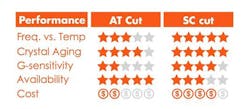Paying attention to whether your oscillator supplier is using temperature-compensated (AT) cut or stress-compensated (SC) cut crystals can help you save money and frustration in the long run with oven-controlled crystal oscillators (OCXOs).
AT Cut vs. SC Cut Quartz Crystals
To understand why electronic-frequency-control (EFC) pull might be creating more costs than benefits, we need to take a closer look at these two types of crystals inside your quartz-crystal oscillators.
For the most part, AT cut crystals are typically cheaper. However, you'll likely end up sacrificing performance in multiple areas, such as:
While SC cut crystals can be more expensive, they typically provide significantly better performance in the same areas mentioned above, as well as availability and cost. The chart below can help give you a better idea of the differences between AT and SC cut crystals.
We talk a lot more about the types of crystals inside your oscillators in this post. Consider checking that out for more on performance qualities of AT and SC cut crystals.
2 Common Impacts of EFC Pull on AT Cut & SC Cut Quartz Crystals in XOs
1. Cost
It's common for design engineers to try and save cost by using less-expensive AT cut crystals in their OCXO designs and using more EFC pull to try and compensate for the lower performance quality. However, this is a myth in many cases and doesn't work out in the long run. Here's why...
If you spec more EFC than you need to cover frequency deviation, costs will significantly increase for the supplier because their overall yield will go down. So, in reality, there are really no cost savings to be found when going with an AT cut crystal and compensating with more EFC pull.
This is one reason why we recommend just sticking with an SC cut crystal in your designs instead of trying to save costs with an AT cut crystal and high EFC pull.
2. Crystal aging
The second benefit to sticking with an SC cut crystal in an OCXO is aging. Using EFC to maintain crystal stability over many months and years is actually very inefficient when compared to using the "natural" stability of a SC cut crystal.
With a 100-MHz SC cut crystal, it'd be realistic to see aging of around 0.1 ppm over a year, whereas an AT cut would exhibit significantly higher aging of around 1 ppm/yr. Expecting EFC to cover for aging in AT cut crystals is, in many cases, not the best option.
Quick Summary
We recommend sticking with SC cut crystals as opposed to AT cut crystals combined with EFC pull when it comes to OCXOs. AT cut crystals combined with EFC don't actually save on costs and can lead to poor performance in the long run.
Bliley’s new Oscillator eCommerce Platform provides a wide variety of SC cut crystal oscillators. Consider exploring the site to find the SC cut oscillator that might best fit your needs.

